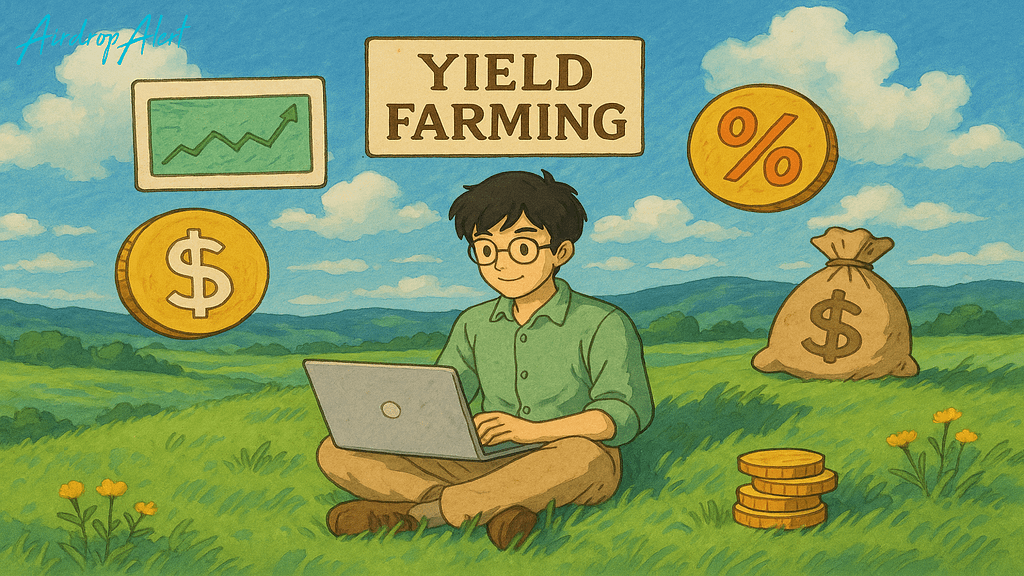Over the past few years, crypto has gone far beyond simple coin transfers. One of the biggest reasons? DeFi.
And within DeFi, one term gets mentioned again and again—yield farming.
If you’ve ever wondered how to make your crypto work for you, this guide will walk you through the basics of DeFi, explain what yield farming really means, and show you how to get started. This topic consists of more than just airdrop farming.
Let’s dig in.
What is DeFi?
DeFi stands for decentralized finance. It refers to financial services built on public blockchains like Ethereum and Solana. Instead of needing banks or brokers, users interact directly with smart contracts—automated programs that run on the blockchain.
These smart contracts let you:
- Lend or borrow assets
- Trade tokens
- Earn interest or rewards
- Access structured financial products
The key here is that DeFi removes middlemen. You stay in control of your assets using a non-custodial wallet like MetaMask or Phantom. No third party holds your funds.
Why DeFi Matters
In countries with stable economies, DeFi might feel like a cool experiment. But in places where inflation runs wild or governments seize assets, DeFi is a lifeline. It offers open, uncensorable access to money.
And even in stable regions, DeFi offers a new way to grow wealth. You don’t need permission to access tools that banks reserve for the wealthy. Anyone with an internet connection can lend, borrow, and earn.

What is Yield in Crypto?
Yield refers to the return you earn on your assets over time.
There are two common terms:
- APR (Annual Percentage Rate) – flat return over a year
- APY (Annual Percentage Yield) – includes compound interest
Both give you an idea of how much you can earn. The higher the number, the more return you’re getting—at least in theory. In practice, risks matter too (we’ll get to that).
What is Yield Farming?
Yield farming is the act of moving crypto across DeFi protocols to earn the highest possible yield. It’s like shopping around for the best interest rate—except it’s done with tokens, smart contracts, and sometimes automated bots.
Yield farming can be simple or complex. Some strategies are low-risk, while others push the limits. But the goal is always the same: earn more on your holdings.

How Do You Earn Yield in DeFi?
There are many ways to generate yield in decentralized finance. Let’s go through the most common methods:
1. Staking Tokens
When you stake tokens, you lock them into a network, often to help secure it. In return, you earn rewards. Ethereum, Solana, and many other Proof-of-Stake chains offer this.
It’s generally low risk—unless the token itself drops in value.
2. Lending on DeFi Protocols
Platforms like Aave or Compound allow you to lend your crypto to others. Borrowers pay interest, and you earn yield. The yield is usually modest (2–8%), but it’s one of the safer ways to put your tokens to work.
Bonus: Some protocols offer additional rewards or airdrops for lenders.
3. Providing Liquidity
This is where DeFi gets interesting. Liquidity providers (LPs) deposit two assets—like ETH and USDC—into a pool. Traders swap between these assets, and LPs earn a portion of the fees.
The potential returns can be high. But watch out for impermanent loss, which happens when the value of one token shifts sharply compared to the other. We’ll cover that more in advanced guides.
4. Yield Vaults
Vaults are smart contracts that manage yield strategies on your behalf. You deposit your crypto (often stablecoins), and the vault allocates it to protocols that generate returns.
Some vaults are managed by protocols like Yearn or Liminal, while others operate on newer ecosystems like HyperEVM.
Vaults are convenient for passive income and often return 8–15% depending on the strategy and token.
5. Protocol Incentives
Some DeFi platforms reward you with their native token for participating. You might earn high APYs—sometimes over 100%—but there’s a catch. These tokens often lose value quickly due to sell pressure.
So, while the returns may look great, they might not hold up if the reward token crashes.
6. Airdrop Farming
Sometimes, protocols don’t reveal what they’re giving away—but they drop hints. Users who deposit funds, interact with contracts, or hold NFTs may get rewarded in future airdrops.
While the yield isn’t immediate, the surprise reward can be significant. This strategy involves more guesswork, but it’s common among experienced DeFi users.
At AirdropAlert, we publish new airdrop opportunities for you every day.

7. Automated Yield Strategies with AI Agents
Emerging tools use bots or AI agents to optimize your capital. These agents move funds across protocols automatically, seeking the best returns.
Platforms like YieldSeeker aim to simplify this for users. It’s early days, but the future likely involves more automation to make farming easier and safer.
Understanding the Risks
DeFi can be powerful. But it isn’t without risk. Here are a few things you should always consider before chasing high yields:
- Smart Contract Bugs – Code errors can lead to exploits and fund loss.
- Rug Pulls – Projects can vanish overnight, taking user funds with them.
- Token Inflation – Protocols that print too many rewards usually see price drops.
- Stablecoin Depegging – Not all stablecoins hold their $1 value.
- Governance Attacks – Bad actors can take over votes in decentralized systems.
- Blockchain Risk – If the network fails, the apps on top go down too.
Even if a protocol is audited, that doesn’t make it 100% safe. And if you can’t explain where your yield is coming from—you might be the yield.
Who Should Try Yield Farming?
Most people probably shouldn’t actively farm yields every day. It requires a lot of attention, knowledge, and capital. Mistakes can be costly.
That said, there are great passive options. If you already hold ETH, stake it. If you have stablecoins, lend them. If you’re looking for a bit more, consider a vault with a proven track record.
These options still offer solid returns—often better than banks—with far less effort or risk.

Is Yield Farming Worth It?
That depends on your experience level, risk tolerance, and goals.
If you’re just starting out, test things with small amounts. Learn how wallets work. Try a staking platform. Then slowly explore lending or vaults.
If you’re more advanced, you can look into LP strategies, point farming, or automated tools. Just make sure to track your rewards, monitor the risk, and don’t chase crazy returns without doing research.
Final Thoughts
Yield farming is one of the most creative areas of DeFi. It lets you earn on assets you already hold. It can also be complex, risky, and time-consuming.
Start slow. Learn by doing. Don’t invest more than you can afford to lose. And always ask one question: “Where is this yield coming from?”
If the answer isn’t clear, walk away.
In our next post, we’ll dive into specific strategies, including how to farm airdrops, optimize LP positions, and use automated tools to grow your stack. Whether you’re farming on Ethereum, Solana, or a new chain—there’s something for everyone.
Until then, farm safe.



